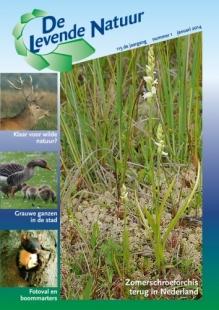De Levende Natuur nummer 1 van 2014 (English summary)
Afbeelding

Rewetting of the Wierdense Veld bog: from experiment to practice
H.B.M. Tomassen, L. van Tweel-Groot & A.J.P. Smolders
Wierdense Veld, a Natura 2000 site, is a raised bog remnant in the eastern part of The Netherlands. Drainage, peat extraction and atmospheric nitrogen deposition severely affected the characteristic bog vegetation, dominated by peat mosses (Sphagnum species) and resulted in a dominance of higher plants (mainly Molinia caerulea). Preliminary research indicated that severe desiccation is hampering the redevelopment of typical bog vegetation and consequent peat formation. The possibility to restore the vegetation by taking rewetting measures was tested experimentally by rewetting desiccated peat monoliths. Within a year the coverage by peat mosses increased at the expense of the grasses. The experiment showed that within a time frame of 10 years peat formation and thereby the development of a new acrotelm can start, provided that peat forming peat mosses are present. Recently, rewetting measures have been completed, involving blocking of drainage ditches and application of foil screens to diminish lateral water losses. Considering the development of the rewetted peat monoliths, we have high expectations for restoring raised bog vegetation at the Wierdense Veld site. To follow the effects of the measures taken, a monitoring program is essential.
Predation in an urban population of Greylag Geese (Anser anser) in Zoetermeer
F.W.J. Havekes, M. Snoek, D.D. Ofman & M.J.M. Hoogkamer
Nest success and brood survival were studied in two urban populations of Greylag Goose (Anser anser) in Zoetermeer, province Zuid Holland. In both island breeding colonies reproductive success stabilized at 1.7 young fledged per breeding pair. We assume that in 2013 the colony of Westerpark was visited by Red Fox (Vulpes vulpes), depredating at least 40% of the nests. Nine adult geese were found killed. Only 10% of the goose eggs found in Westerpark hatched in 2013, against 50-60% in previous years.
The effect of predation seemed cumulative to other factors that affect nest success. We assume that Red Fox specifically targets incubated nests or has an indirect effect on nest success of neighbouring non-visited nests. Reproductive success decreased to only 0.3 young fledged per breeding pair.The difference in gosling survival between 2013 and previous years was less obvious. Gosling depredation probably occurs mainly outside the breeding colony. Nonetheless, we suspect that depredation is the major cause of the recent decline in gosling survival in Zoetermeer.
The breeding birds of the Beninger Slikken,1969-2013
J.W.M. Kuijpers
The Beninger Slikken is a 230 ha large nature reserve in the former estuary of the Rhine and Meuse. It is part of the Natura 2000 area ‘Haringvliet’. This paper describes the changes in the breeding bird population from 1969 to 2013.In 1970 the estuary was closed off from the sea by a dam with outlet sluices. The tidal difference diminished from 2 m to 30 cm and the salinity of the water dropped from 3000 mg Cl/l to less than 200 mg Cl/l. The former vegetation of bulrushes and reed was gradually replaced by tall herbs and in some places shrubs developed. About1979 the area came under the management of Natuurmonumenten that transformed parts of the area into grasslands in order to get a suitable habitat for wintering geese and breeding habitat for birds like Black-tailed Godwit (Limosa limosa), Redshank (Tringa totanus) and Lapwing (Vanellus vanellus). After 1970 the number of breeding species increased but typical reed birds like Bittern (Botaurus stellaris), Water rail (Rallus aquaticus) and Bearded tit (Panurus biarmicus) disappeared or greatly diminished in numbers. After some initial increase also the numbers of meadow birds dropped. New breeding birds were a.o. Bluethroat (Luscinia svecica), Greylag goose (Anser anser) and Barnacle goose (Branta leucopsis).It is argued that many of the observed changes on a level of individual species are the result of large scale population changes and not the result of local nature management. From the point of nature conservation the most important group of breeding birds are the species of reed and tall herb vegetations. The future nature management should aim at the preservation of this type of habitat. Grazing may not be the best way to do this.
Summer Lady’s tresses (Spiranthes aestivalis) rediscoved in The Netherlands
C.A.J. Kreutz
After almost a century the Summer Lady’s tresses (Spiranthes aestivalis) is in 2012 rediscovered in The Netherlands. The site is situated south of Eindhoven. This article deals with the historical records as the actual situation in The Netherlands and Europe.

